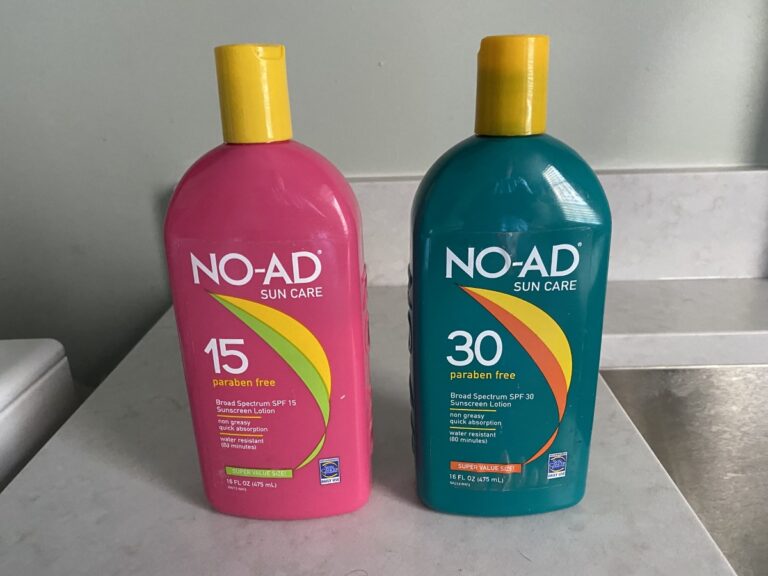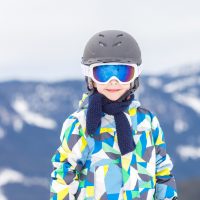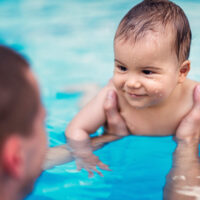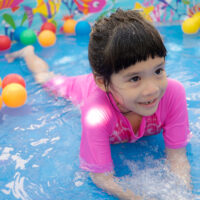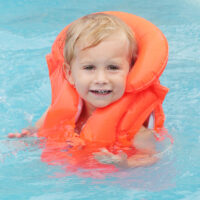As a seasoned meteorologist, I can tell you that the sun is one of the most underrated weather hazards that can harm your child, whether it be due to the heat or the ultraviolet rays. Up until 6 months of age, doctors have recommended covering your little one up while out in the sun, but as they start to become more mobile, it becomes even more necessary to protect their delicate skin.
We investigated the top products on the market to keep your kids safe from the sun as well as certain harmful chemicals.
Always check with your pediatrician before starting any new products.
Best Sunscreen for Babies with Eczema
The Aveeno Baby Sunscreen Lotion is tear free, water resistant, and is SPF 50, while the CeraVe Mineral Baby Sunscreen is SPF 45 and it is water resistant and hypoallergenic.
Neutrogena Pure & Free Baby Sunscreen Lotion
Why We Love It
If you are looking for a lotion that provides exceptional coverage and accommodates sensitive skin types, this is a wonderful choice! Moreover, Pure & Free is an affordable option with a name that you can trust! It is available in lotion and stick forms, so you can choose the preference that is best for your little one!
Why We Don’t Love It
The product is described as tear-free, but there have been some reports of irritation. Taking extra care when applying the sunscreen lotion around the eyes and mouth as well as allowing it to soak in for fifteen to thirty minutes prior to heading outdoors can help prevent this issue. If your little one is extra squirmy, consider purchasing the stick variety for application to their face! It contains potential irritants/allergens and other ingredients linked to toxicities and clogged pores. It was rated 3 by EWG (Environmental Work Group).
Considerations
- SPF 50
- Broad Spectrum
- Water Resistant
- Hypoallergenic
- Dermatologist Tested
- NEA Seal of Acceptance
CeraVe Mineral Baby Sunscreen
Why We Love It
CeraVe is a brand developed and promoted by dermatologists. It’s hard to compete with a company whose expertise is in protecting your skin! With this being said, their baby sunscreen provides an extra boost of protection through added compounds that moisturize and restore damaged skin cells! It was rated 2 by EWG.
Why We Don’t Love It
The texture can be a bit grainy so it doesn’t go on quite as smooth as other products on the market. Moreover, this sunscreen does have a slightly lower SPF, which means you will need to reapply more often than compared to those with higher protection. Additionally, this option is slightly more expensive, but if your child has a history of eczema AND an allergy to colloidal oatmeal, it is your best bet! It contains other potential irritants/allergens and other ingredients linked to toxicities.
Considerations
- SPF 45
- Broad Spectrum
- Environmentally friendly
- Water Resistant
- Dermatologist Recommended
- Contains compounds that provide added protection
- Hypoallergenic
- NEA Seal of Acceptance
Aveeno Baby Sunscreen Lotion
Why We Love It
This is another brand synonymous with exceptional skin care! Not only that, but Aveeno Baby promises a tear-free product, which we know if imperative with little ones! Furthermore, it contains oats to help preserve the moisture in your baby’s skin. Finally, this is a top of the line product for babies who have a history of eczema.
Why We Don’t Love It
While the purpose of water resistant, mineral sunscreens is to stay on longer, this sun protectant is extremely thicker than other varieties, meaning that is can be harder to get off in the shower or tub once your kids are done having fun in the sun. Additionally, while most children do not have issues with colloidal oatmeal, for those that have a sensitivity, this is not a good choice as it can cause allergic reactions. It contains other potential irritants/allergens and other ingredients linked to toxicities and clogged pores. It was rated 5 by EWG.
Considerations
- SPF 50
- Broad Spectrum
- Environmentally friendly
- Water Resistant
- Tear-Free
- Colloidal Oatmeal
- Dermatologist Recommended
- NEA Seal of Acceptance
- Hypoallergenic
Best Broad Spectrum Sunscreen for Babies
The Baby Bum Sunscreen Lotion is a zinc based lotion with an SPF of 50 which allows it to stay on longer, providing more sun protection, however, the Babo Botanicals Spray Sunscreen is also zinc based but is a spray on sunscreen and only offers SPF 30 protection.
Baby Bum Sunscreen Lotion
Why We Love It
This lotion not only protects against UVA and UVB rays, but it also has added ingredients to nourish and moisturize your baby’s sensitive skin, while absorbing quickly! Baby Bum is another hypoallergenic alternative that has been tested by dermatologists and pediatricians to ensure your little one’s skin stays safe! It was rated 2 by EWG.
You will love that this option is a gift set with a face sunblock, body sunblock, and a monkey toy too!
Why We Don’t Love It
This is another variety that has a grainy texture. It also goes on pretty thick, leaving a white residue on the skin. This tends to happen with zinc based options, but it means that it will stay on longer, aka more sun protection. There are other more lightweight sunscreen brands available, but if you choose to go with another route, make sure to apply more often because the amount of protectant will be less. It contains potential irritants/allergens and other ingredients linked to toxicities.
Considerations
- SPF 50
- Broad Spectrum
- Mineral-Based Ingredients
- Water Resistant
- Hypoallergenic
- Pediatrician and Dermatologist Tested
- Contains Plant Fats to Nourish Skin
Blue Lizard Australian Sunscreen
Why We Love It
This is a fantastic broad spectrum, water resistant option that is made with safe, mineral-based ingredients and provides long lasting protection. Best of all, the Blue Lizard bottle is created to let you know when it is time to reapply! The white exterior will slowly turn pink as it is exposed to UV light, giving you an easy way to know when to slather on some more.
Why We Don’t Love It
This sunscreen does contain aluminum. While this ingredient is effective at blocking the dangerous rays of the sun, some research has shown that this can cause health impacts, with enough exposure over time. It contains other potential irritants/allergens and other ingredients linked to toxicities and clogged pores. It was rated 3 by EWG.
Considerations
- SPF 50
- Broad Spectrum
- Environmentally friendly
- Mineral-Based Ingredients
- Smart Bottle
- Water Resistant
- Pediatrician Recommended
Coppertone Pure & Simple Baby Sunscreen
Why We Love It
This is a cost effective choice that is free of fragrances that can sometimes irritate sensitive skin. Coppertone is synonymous with sun protection and this baby sunscreen has a smoother consistency than others so it applies easily and doesn’t leave a residue.
Why We Don’t Love It
Unfortunately, this lotion has a tendency to dry out your baby’s sensitive skin. Keep in mind that you get what you pay for, with the more expensive options having added ingredients to prevent this problem. It contains potential irritants/allergens and other ingredients linked to toxicities and clogged pores. It was rated 5 by EWG.
Considerations
- SPF 50
- Broad Spectrum
- Water Resistant
- Tear-Free
- Hypoallergenic
- Affordable
Babo Botanicals Sheer Spray Sunscreen
Why We Love It
If you prefer a spray over a lotion, this is a spectacularly safe and lightweight choice that has moisturizing oils and aloe to make your kid’s skin feel soft and supple after each use! Babo is ideal for older kids and adults alike.
Why We Don’t Love It
This sun protectant is a lower SPF than other varieties, which means you will have to reapply more often. Moreover, while older kids can stay still and close their eyes on command, babies are not quite as cooperative. Due to this, sprays are not recommended because of the risk of contact with the eyes and mouth. It contains potential irritants/allergens. It was rated 6 by EWG.
Considerations
- SPF 30
- Broad Spectrum
- Environmentally friendly
- Water Resistant
- Hypoallergenic
- Spray Sunscreen
Best Natural Sunscreen for Babies
While both natural sunscreen choices have an SPF 50, the Thinkbaby Natural Sunblock contains 20% of zinc oxide which allows protection from the sun, yet Babyganics Sunscreen Lotion only has 6% zinc oxide so you will need to apply more often.
Thinkbaby Natural Sunblock
Why We Love It
You will leave the sticky feeling of sunscreen behind when you slather on this Thinkbaby lotion! In addition, this option has a great smell and stays on longer than most water-resistant brands. Best of all, this sun protectant contains vitamins, aloe and various seed oils to make sure dry skin stays at bay! It was rated 2 by EWG.
Why We Don’t Love It
While filled with moisturizing ingredients, those with eczema always need to take a little extra caution when selecting products for their skin. This sunscreen tends to leave those with more sensitive skin feeling a bit itchy due to flare ups. It contains potential irritants/allergens and other ingredients linked to toxicities.
Considerations
- SPF 50
- Broad Spectrum
- Environmentally friendly
- Water Resistant
- Non-toxic
- Affordable
Babyganics Sunscreen Lotion
Why We Love It
Babyganics is another extremely affordable option that doesn’t skimp on quality! Additionally, this sunscreen is formulated with natural oils that give your kids an extra dose of Vitamin E! If you are looking for a more natural alternative, this is the sunscreen for you!
Why We Don’t Love It
This lotion contains a much lower percentage of zinc oxide and titanium dioxide. That means that you will have to reapply more often than compared to other products to ensure that your child doesn’t get burned. It contains potential irritants/allergens and other ingredients linked to toxicities. It was rated 3 by EWG.
Considerations
- SPF 50
- Broad Spectrum
- Environmentally friendly
- Includes Natural oils
- Water Resistant
- Tear-Free
- Non-allergenic
- Affordable
Comparing Baby Sunscreen
The table below compares only the recommended products on this page. A low or high Price means it is low or high compared to the other products listed. The Popularity Score reflects how often readers click on and buy the product. The Quality Score is our assessment of the overall performance and satisfaction with the product compared to others in the table.
Top Considerations When Buying Baby Sunscreen
SPF
Dermatologists recommend a SPF, or Sun Protection Factor, of at least 30 or higher for all children. It is important to remember that the sun does not discriminate, so no matter what color your child’s skin may be, everyone has an equal risk of causing detrimental damage to their skin if they chose to forego using sunscreen.
Active Ingredients
The top ingredients to look for to ensure ample protection of your baby’s skin are zinc oxide or titanium dioxide. These are minerals that occur naturally and are less likely to be absorbed into your child’s skin.
Conversely, chemical-based sunscreens include ingredients like oxybenzone and octinoxate, which absorb into the skin and can cause a myriad of health issues and skin irritations over time.
Broad Spectrum
Broad-spectrum sunscreen means that it protects against UVA and UVB rays. These are the two types of UV light that the sun produces. “A” stands for aging and “B” stands for burning. Both can cause long term health impacts if your child is exposed for too long, so protecting against both is always best.
Water Resistant
This means that these sunscreens have undergone tests that prove that the product will stay on your child’s skin despite sweating or swimming for a short period of time, not all day. This is a fantastic quality to look for in sunscreen to guarantee a little extra protection.
Tear Free
Children have a way of getting things in their eyes and tear-free sunscreens can give parents some peace of mind when this occurs, whether during the application or when in the water.
Cost
If your child is outside every day, it is imperative that you make sure that they are protected. Unfortunately, this can add up if you are using sunscreen 365 days out of the year. This does not mean to skimp on the quality. It just means to shop around to find the best bang for your buck and buy in bulk when you can!
Environmentally Friendly
This goes back to the active ingredients mentioned above. Since certain chemicals can cause health impacts to your child, it should come as no surprise that those same aforementioned chemical ingredients have also been shown to cause damage to the coral reefs as well as some marine life.
We tell our kids to treat others the way you want to be treated. This should apply to our environment as well!
Allergies
Look for products that are hypoallergenic and that are pediatrician recommended to protect your baby’s sensitive skin. However, even if you grab something that guarantees no issues, it is always best to do a spot test 48 hours prior to full use. This is because many of the inactive ingredients that can moisturize your little one’s skin, could potentially also cause allergic reactions. Take a small amount and test it on your child’s leg or arm. Leave it uncovered and see if any rashes or irritations arise over the next few hours.
Eczema
With at least one in ten kids having childhood eczema, this is an important factor to consider when looking for sunscreen. Certain ingredients in sunscreens can dry skin out, so if your child suffers from this skin condition, consider options that can help prevent this from happening.
Application Method
While less convenient, most pediatricians and dermatologists would agree that a lotion sunscreen guarantees coverage more readily than a spray. This is because most people don’t take the time to rub in spray sunscreen. This leads to an uneven coat of protection. Not only that, young kids, especially babies and toddlers are not always the best at following directions (big surprise), so sprays tend to end up in eyes and mouths which is never ideal.
Finally, while stick varieties are great for pinpointing areas on the face and lessening the chance of getting it in your little one’s eyes, they are less ideal for the body. This is because while patience is a virtue, most of us don’t have enough to sit and streak each section of kid’s bodies with a tiny little stick.
FAQs about Baby Sunscreen
Many of the ingredients included in these products are controversial, or have limited or no data/research on use for babies. Some ingredients have been linked to health problems. Many products have not been evaluated by the FDA. Since no studies have been conducted with these products on babies there is no absolute certainty that these are 100% safe. Always consult with your pediatrician before starting any products on your baby.
Since the FDA does not regulate cosmetic products, the Environmental Work Group (EWG) has created a database of products. It offers information on the most popular products and ingredients, such as whether the product is an irritant/allergen or linked to organ/reproductive toxicities. It rates products from 1 to 10, with 1 being the least toxic. It is best to stick to products that rate EWG verified, 1 or 2.
What is the difference between an SPF of 30 versus an SPF of 50?
The SPF number determines how long you can safely stay in the sun before getting burned. Therefore, if you purchase a sunscreen with an SPF of 30, you can stay in the sun thirty times longer than you would be able to if you were to go without sunscreen.
Keep in mind, if it takes as little as ten minutes to get burned, this implies that you could stay out in the sun for 300 minutes, or five hours, before feeling the effects of the sun. However, this is not the case because it does not account for a lot of factors.
First, if you read the back of the bottle it specifies to apply “liberally” at least fifteen minutes before you go out in the sun. Secondly, it also clearly states that you must reapply at a minimum every two hours in order for it to work properly.
Why? Because the majority of the time, your kids are swimming in the sun and sweating due to heat. This leads to the sunscreen slowly coming off. Not only that but whether your kids are playing a game of chicken in the pool or your little one is crawling around in the sand, these activities can lead to certain areas of the skin losing that layer of protection. Sunscreen needs to re-applied after they get out of the water.
This is why it is always better to go with the higher number and to ALWAYS reapply to dry skin every 1-2 hours!
We will be in the shade most of the day! Do we really need sunscreen?
Absolutely! As mentioned earlier, clouds, as well as rain and fog, cannot completely block out UV rays. Not only that, but up to 85% of the sun’s harmful rays bounce off of water, snow, concrete, sand, and other reflective surfaces, which can cause an even more intense burn. This is because your skin feels the impacts of both the sun’s direct rays as well as the reflected rays from the surface you are near.
It is Winter and I am in the mountains so I don’t need sunscreen, right?
Wrong! Sunburn can happen any time of year! Furthermore, the higher in elevation you are, the closer you are to the sun! The intensity of the UVA and UVB rays goes up by almost 5% for every thousand feet you go up so if you plan to hike or ski with the family, make sure to lather it on before heading out!
Why should I choose a mineral-based baby sunscreen over a chemical-based one?
Mineral-based sunscreens work like an umbrella. They deflect the sun’s rays off of your baby’s sensitive skin. Chemical-based lotions absorb the detrimental UV rays, but they also absorb into your child’s skin and bloodstream. If your kids tend to spend an extended amount of time outdoors, these are not recommended. That’s because over time this product can cause health issues.
How much baby sunscreen do I need to apply?
The general rule of thumb is a full shot glass for adults and half a shot glass for kids. You always want to apply liberally and rub it in no matter if you use a spray, lotion, or stick.
Do I still need to reapply every two hours if it is advertised as ‘water and sweat resistant’?
Yes! While these stay on you and your family’s skin better than other varieties, it is still important to reapply every two hours to guarantee that it is effective. Remember that any time your child sits down, hops on a float, or plays in the sand, they are slowly removing that initial layer of protection and letting in the sun’s harmful rays.
Why does my baby need to use sunscreen if they have dark skin?
Even if you can’t always see the burn, the damage is still occurring. In fact, the survival rates for colored skin individuals are way lower than that of caucasian individuals. Not only that, but according to the Skin Cancer Foundation, most instances of cancer in non-white individuals occur on the bottoms of the feet, an area where most of us neglect to apply sunblock.
The best way to prevent sunburns and skin cancer is to be proactive with sunscreen and cover.
What is the NEA Seal of Acceptance?
The NEA, or National Eczema Association, awards the Seal of Acceptance to sunscreen products that are broad-spectrum, an SPF of 30 or greater, contain mineral-based protectants, and are free of alcohols. This last requirement is extremely important as alcohol can dry out the skin with can agitate eczema patches.
If your child has eczema, what ingredients should you look for and which should you avoid?
We already mentioned avoiding alcohols, but you will also want to steer clear of fragrances, dyes, parabens, and chemical protectants like oxybenzone and octinoxate.
What you need are the mineral-based ingredients we discussed, as well as natural oils, fats, Vitamin E and D, aloe, oats, and other moisturizers. Finding options with ceramides and hyaluronic acid that repair damaged skin are great additions as well.
What is best for my baby — lotion, spray or stick sunscreen?
Lotion is always the best. Sprays can be detrimental to your little one’s eyes and can end up in their mouths due to their squirmy nature. Because of this, lotion or stick sunscreen varieties are the best options for babies. However, once your child can close their eyes, and keep them closed when asked, they can use spray or lotion with no issue. Nevertheless, it is important to always remember to apply a liberal amount to wet the skin and rub it in! Even a small breeze can take a good portion of the spray sun protectant away before it hits their skin.
Does baby sunscreen expire?
Yes! Most options will last up to three years, but it is best to make a habit of checking the bottle if you didn’t recently purchase it. Another tip to ensuring that your sunscreen maintains its effectiveness is to keep the bottle out of direct sunlight.
Should we avoid the sun altogether?
You do not have to avoid all sun. You just have to realize that sunscreens help prevent a large amount of sun damage, but it does not prevent all of it. Sunscreens do not make you bullet-proof. You always want to minimize the amount of sun your baby gets. The most damaging sun exposure occurs for people under 18 years of age.
Sun exposure leads to the natural production of Vitamin D, boosts mood, enhances sleep, and improves immune defense! When you let your kids out in the sun, make sure they have proper sun protection, limit the amount of time, and avoid going out during peak heating hours to prevent overexposure to the sun’s harmful rays as well as the chance of heat-related illnesses and dehydration. If you’re going to the beach, check out our list of the Best Baby Beach Gear for protection here.
Can I use baby sunscreen on my child before 6 months of age?
Infants under six months old have extremely sensitive skin, therefore sunscreen is not recommended before this time. This is because contact dermatitis and other skin conditions are more likely during this time of their life. If you have a young infant outside, make sure that they stay covered with clothing and hats and remain under shade.
What is a photo-allergic reaction and what can cause it?
Just like your child can be allergic to penicillin or blueberries, they can also have reactions to certain ingredients. This can be enhanced by sunlight, leading to red bumps forming on the skin, otherwise, know as contact dermatitis. The most common ingredient that can cause this is chemical-based — Oxybenzone.
What kind of health impacts can a bad sunburn have on my child?
Short term impacts of a sunburn can range from discomfort and dehydration to much more serious heat stroke and even shock. The latter two listed need immediate medical attention to prevent long term health issues and even death.
The main long term impact of sunburn is skin cancer, which becomes more of a risk with each burn your child gets. This is why it is extremely important to protect your children’s skin with sunscreen, clothing, shade, and breaks indoors. Each sunburn doubles your chance of getting melanoma, which is a deadly form of skin cancer.
What else can I do to protect my baby’s skin?
Obviously, sunscreen is a must, but so is avoiding the sun’s harmful rays when they are at their strongest. This occurs at the same time we see peak heating — 10 AM to 4 PM. Now, this can be hard to avoid in the Summer months, so also consider taking breaks in the shade, wearing loose and light-colored clothing that provides extra coverage, and don’t forget the sunglasses and hats!
Additionally, there are now clothing lines that make sun-safe apparel for kids and adults to serve as an extra line of defense! Just like sunscreen, they block UV radiation!
Is there a way to avoid the ghostly white appearance that some baby sunscreens cause?
Not if you want effective protection. Zinc oxide goes on white and tends to not rub in quite as well as other ingredients. That’s because it is working as a layer ABOVE the skin. While it is not the most appealing look, it is better than the red color your skin will likely have when you leave the beach or pool after foregoing sunscreen use.
Can babies use adult sunscreens? Is there even a real difference?
Technically, the answer is yes, but you will want to check the ingredients list first and check with your pediatrician. That’s because most adult sunscreens tend to be chemical-based and contain fragrances and dyes that can cause reactions on your child’s delicate skin.
Furthermore, if you choose to use your child’s sunblock, remember that most options that are tailored for kids tend to bring a ghostly glow to the skin due to the zinc oxide.
If my child does get burned, how do I treat it?
First and foremost, get them inside! Put them in a cool bath or apply a cool compress. Make sure that they hydrate and apply aloe vera gel. If you notice a fever, extreme pain, blistering or odd behavior, contact your pediatrician or a healthcare provider immediately.
Finally, do not let them back out in the sun until the burn is completely healed. Doing so could lead to detrimental skin damage and could exacerbate their symptoms.
